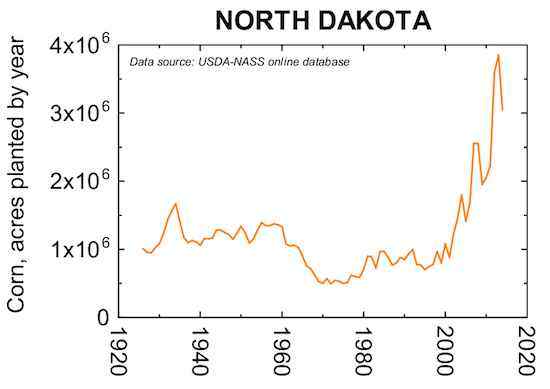By Sierra Rayne ——Bio and Archives--July 26, 2014
Global Warming-Energy-Environment | CFP Comments | Reader Friendly | Subscribe | Email Us
Warmer temperatures -- which give corn plants more days to mature -- have helped make it more practical to plant the crop in North Dakota. In the past 100 years, the state's average temperature has risen 2.7 degrees, lengthening the growing season by an average 1.2 days per decade, said Adnan Akyuz, the state's climatologist.This doesn't appear to be accurate, either. According to the NOAA database, the 1913-2012 trend (aka, "the past 100 years") -- remembering that 2013 annual data wasn't available when this WSJ story was written -- in North Dakota's average temperature is only 2.2°F. Akyuz's claimed trend is almost 25 percent higher than the actual trend. And Akyuz's basic math on the length of the growing season doesn't add up. In the first story, we read that "the length of the growing season has increased 17.5 days in the last century" while the second story states that "in the past 100 years, the state's average temperature has risen 2.7 degrees, lengthening the growing season by an average 1.2 days per decade." Multiply 1.2 by ten (i.e., ten decades in 100 years) and you get 12, not 17.5. Who knows what is going on with this apparent 50 percent difference in the rate of change for the growing season during the past century, both sourced from the same individual just a few months apart. But there are also critical details that this over-simplified climate reporting omits. Since the late 1960s, there has been no significant trend in North Dakota's average temperature, and over the past 30 years the correlation has turned negative towards cooling. So, yes, North Dakota is warmer now than it was a century ago, but the past five decades have seen no change in its average temperature, and the past three decades hint at a possible cooling trend. How does this square with anthropogenic climate change supposedly leading to the massive increase in corn production for the state over the past decade? Even the agricultural trade publications can't get the information about corn and North Dakota correct. The Farm and Ranch Guide reported the following last October:
"The corn industry's impact on North Dakota's economy has grown substantially over the past 40 years, in which the state's corn cropland has increased 8 percent."Rather than just an 8 percent increase in "the state's corn cropland" over the past 40 years, the increase was 562 percent -- from 0.54 million acres in 1973 to 3.6 million acres in 2012. And when we look at the corn area planted in North Dakota each year dating back to 1926, it becomes abundantly clear that climate change has effectively nothing to do with the recent increase.
 This finding gets reinforced by the fact that changes in average annual temperatures aren't particularly useful for assessing crop production of annual plants such as corn. Growing season average temperatures are a far more useful indicator. The May through November period is the typical growing season for corn in North Dakota. There hasn't been a significant trend in the state's average temperature during the corn growing season over the past century, or since 1970, or over the past 30 years.
Even worse for those attempting to put forward the climate change argument as an explanation for North Dakota's recent rapid rise in corn production is the simple fact that growing degree days haven't exhibited any significant trend over the past century for any of the state's climate regions in the NOAA-NWS database -- and no significant trends over the past three decades, either.
It seems that every time there is a change in something, it must be due to climate change. A consistent climate change narrative has been spun all throughout the media for many years now, and most of it is entirely incorrect.
So what has led to North Dakota's increasing corn acreage since 2002? Money, and advancements in agricultural technology. This is the correct causal link, and the information is out there if you look hard enough for it -- often hidden behind some climate change related babbling.
Here are some quotes from the media articles I've cited already that explain what is really going on:
This finding gets reinforced by the fact that changes in average annual temperatures aren't particularly useful for assessing crop production of annual plants such as corn. Growing season average temperatures are a far more useful indicator. The May through November period is the typical growing season for corn in North Dakota. There hasn't been a significant trend in the state's average temperature during the corn growing season over the past century, or since 1970, or over the past 30 years.
Even worse for those attempting to put forward the climate change argument as an explanation for North Dakota's recent rapid rise in corn production is the simple fact that growing degree days haven't exhibited any significant trend over the past century for any of the state's climate regions in the NOAA-NWS database -- and no significant trends over the past three decades, either.
It seems that every time there is a change in something, it must be due to climate change. A consistent climate change narrative has been spun all throughout the media for many years now, and most of it is entirely incorrect.
So what has led to North Dakota's increasing corn acreage since 2002? Money, and advancements in agricultural technology. This is the correct causal link, and the information is out there if you look hard enough for it -- often hidden behind some climate change related babbling.
Here are some quotes from the media articles I've cited already that explain what is really going on:
View Comments
Sierra Rayne holds a Ph.D. in Chemistry and writes regularly on environment, energy, and national security topics. He can be found on Twitter at @srayne_ca